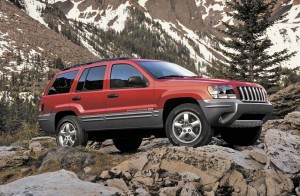
The new database will let buyers and owners search automaker databases to see if a vehicle - like this 2004 Jeep Grand Cherokee -- still needs repairs.
Recalls have long been a way of life for automakers and auto buyers alike. But federal regulators have announced a critical new step to ensure that when a vehicle is subject to a safety campaign the necessary repairs actually get made.
The new rules revealed by the National Highway Traffic Safety Administration should prove a boon to both owners and car shoppers alike by making it easier to not only see if a vehicle has been subject to a recall but whether it has been repaired.
The government also will provide a searchable database.
“Safety is our highest priority, and an informed consumer is one of our strongest allies in that effort,” said U.S. Transportation Secretary Anthony Foxx. “Owners and potential buyers alike will soon be able to identify whether a safety recall for their specific vehicle is incomplete, using our free online search at SaferCar.gov.”
It’s one of the rare instances where industry, consumer advocates and regulators are in lockstep agreement and it comes at a time when the number of recalls appears to be on the rise again after years of steady declines.
Under the new rule, all manufacturers will have to set up easy-to-access web pages where the public can enter a car, truck or crossover’s Vehicle Identification Number, or VIN, to check its recall history. Motorcycle manufacturers also will be covered by this first-time rule. NHTSA will require manufacturers to update the information at least once a week.
“The goal here is to increase recall completion rates through greater consumer awareness,” said the automotive trade group, the Alliance of Automobile Manufacturers, noting that the industry supports the plan for “Providing safety recall information on the websites of automakers.”
A study of the NHTSA database for 2012 found 16.2 million vehicles covered by safety campaigns last year – a figure that also included motorcycles and recreational vehicles, or RVs – a 4.5% increase over 2011.
Meanwhile, the initial pace for 2013 suggests the industry could see another increase, numerous safety experts have cautioned, especially in light of some of the year’s biggest recalls which have generated numbers in the 100s of thousands, even the millions. That includes roughly 1.5 million Jeep products covered by a June campaign due to a fire safety risk, and another problem affecting 250,000 General Motors SUVs also announced that month.
Fire hazards have been a particularly big issue during the last year – in fact, Toyota announced a recall covering 7.5 million vehicles last autumn due to faulty power window switches that could short out and catch fire. But defective airbags have also become a major problem involving millions of vehicles since the beginning of 2012 alone, impacting makers such as Honda, BMW and Nissan.
Part of the problem is that as the industry shares more common components in a bid to reduce costs and complexity a defect can impact a wide range of models and brands, often slipping under the radar screen for consumers.
Meanwhile, NHTSA also orders a number of recalls each year impacting only a handful of vehicles that might have been produced on one specific day. Chevrolet recently issued a service order for just four Volt plug-in hybrids due to a software glitch with their electronic stability control.
(Parents teaching kids distracted driving habits. For more information, Click Here.)
Complicating matters, some vehicles are subject to multiple recalls making it even harder for consumers to stay on top of safety matters. Honda last month recalled some Fit models due to a fire hazard after an earlier repair failed to fix the problem.
NHTSA notes that only about 70% of the vehicles covered by the typical recall wind up being repaired, including those vulnerable to the most serious safety problems. Even when makers go out of their way, repeatedly notifying owners directly, as Toyota did after a series of issues related to unintended acceleration in 2010 and 2011, the figure seldom climbs above 80%.
(Click Here to read about Ford’s $17-million payment to avoid fight with NHTSA.)
In some cases, that’s because older vehicles have been scrapped, but many unrepaired vehicles remain on the road, a risk to both current owners and to those who might buy the vehicles on the used market.
Automakers will be given a year to comply with the new NHTSA guidelines. The web databases will only be required to show vehicles that have not had repairs made. Those that have been fixed won’t need to be listed.
